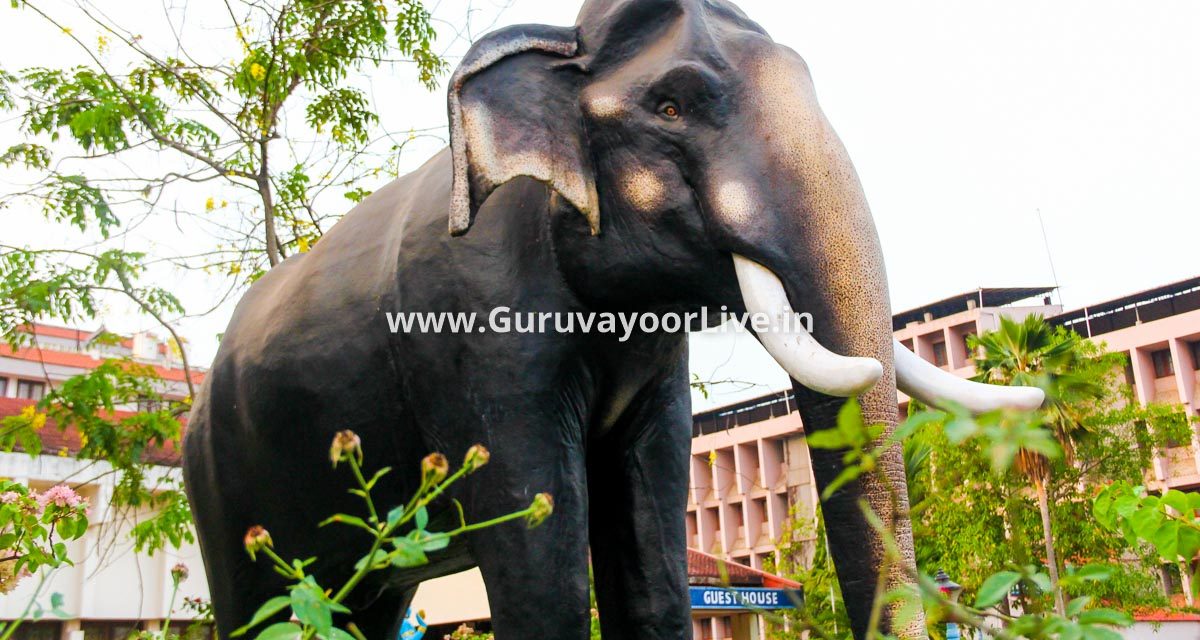

Gajarajan Guruvayoor Keshavan (died December 2, 1976) is perhaps the most famous and celebrated captive elephant in Kerala, southern India. Keshavan was donated to the Guruvayoor Hindu temple by the royal family of Nilambur on 4 January 1922. It is a common Hindu custom in Kerala to capture elephants either as calves or young adults from the wild and to donate them to the deity of the temple as an offering. Guruvayoor temple has in excess of 50 elephants.
Standing over 3.2 meters tall, Keshavan was known for his devout behavior. Keshavan died on December 2, 1976, aged 72, which happened to be Guruvayur Ekadasi, considered a very auspicious day. He fasted for the entire day and dropped down facing the direction of the temple with his trunk raised as a mark of prostration. The anniversary of his death is still celebrated in Guruvauyur. Many elephants line up before the statue and the chief elephant garlands it. Keshavan was conferred the unique title "Gajarajan" (Elephant King), by the Guruvayoor Devaswom.
The Guruvayoor Devaswom erected a life-size statue of Keshavan in its precincts as the tribute to the services he rendered to the presiding deity of the temple. Its tusks, along with a majestic portrait of the elephant, can be still seen adorning the entrance to the main temple enclosure. Its life is the subject of the 1977 Malayalam feature film Guruvayur Kesavan, released the year after his death. The film was directed by Bharathan, starring M. G. Soman, Adoor Bhasi, Sankaradi, Bahadoor, Jayabharathi, Vennira Aadai Nirmala (ushakumari), Veeran, Oduvil Unnikrishnan, junior Sheela, M S Nambudiri, N Govindankutty, Paravoor Bharathan and Manavalan Joseph zoomed by Ashok Kumar (cinematographer). The story of Guruvayoor Kesavan was later portrayed in a television serial on Surya TV, (2009—2010).
Now let's know about Guruvayur Temple. Guruvayur Sri Krishna Temple is a Hindu temple dedicated to the Hindu god Guruvayurappan (a four-armed affiliation of the Hindus god Vishnu), located in the town of Guruvayur in Kerala, India. It is one of the most important places of worship for Hindus of Kerala and is often referred to as Bhuloka Vaikunta. which translates to the "Holy Abode of Vishnu on Earth".
The presiding deity of the Guruvayur Temple is Vishnu, worshipped in the form of Guruvayurappan. The central icon is a four-armed standing Krishna carrying the conch Panchajanya, the discus Sudarshana Chakra, the mace Kaumodaki and a lotus with a Holy basil garland. This image represents the majestic form of Vishnu as revealed to Krishna's parents Vasudeva and Devaki around the time of Krishna's birth; hence Guruvayur is also known as "Dwarka of South India". He is currently worshipped according to routines laid down by Adi Shankara and later written formally in the Tantric way, the inter-religious spiritual movement that arose in medieval India, by Cennas Narayanan Nambudiri (born in 1427). The Cennas Nambudiris are the hereditary tantris (high priest) of the Guruvayur Temple.
The temple (puja) routines are strictly followed. The tantri is available full-time at the Temple to ensure this. The Melsanti (Chief Priest) enters the sanctum sanctorum in the morning and does not drink anything up to the completion of "noon worships" at 12:30 PM.
According to legends, the deity worshipped here is more than 5000 years old. In the 14th century, "Kokasandesam" (a Tamil literary work), references to a place called Kuruvayur are made. As early as the 16th century (fifty years after Narayaniyam was composed) many references to Kuruvayur are seen. In ancient Dravidian languages, "kuruvai" means "sea", hence the village on the Malabar Coast may be called Kuruvayur. The earliest temple records date back to the 17th century. The earliest mention of the many important Vishnu temples of Kerala are found in the songs of Alwars, Tamil saints, whose time-line is not exactly fixed. Mamankam was a very famous local event at Tirunavaya, on the bank of Bharatappuzha. The battles between the Kozhikode under Samoothiris and Valluvanad popularised Guruvayur Temple. Due to the prolonged battles, people across the riverbank started preferring Guruvayur. Even the Samoothiri of Kozhikode become a devotee and thus his subjects followed him. The central shrine that is seen today is said to have been rebuilt in 1638 AD. "Viswabali" was performed later to propitiate all the spirits, good and bad. By the end of the 16th century Guruvayur had become the most popular pilgrimage centre in Kerala.









